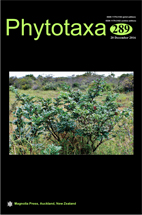Abstract
More than a century ago, the comprehensive account of the Piperaceae in the Flora of British India by Hooker (1886) listed 45 species of Piper (including Pothomorphe) and ten species of Peperomia from India, Bangladesh, Myanmar, Nepal, Philippines, Sri Lanka as well as the Indonesian islands Java and Sumatra. The genus Piper was treated under six sections, wherein he listed 28 species from present day India. Several years later, C. de Candolle (1923) recognized 95 species of Piper and eight of Peperomia from India, including 41 species of Piper that were new, although they were not described fully until 1925. A number of new species and varieties were also added by Van Heurck & Müller Argoviensis (1871), C. de Candolle (1910, 1912), Gamble (1924), Ravindran et al. (1987), Babu et al. (1993), Gajurel et al. (2001 a & b, 2007), Lekhak et al. (2012), and Mathew et al. (2016). In the meantime, some regional accounts of the genus Piper were also published, including Rahiman & Nair (1987) from Karnataka, Gajurel et al. (2002, 2008) from Arunachal Pradesh, and Das et al. (2010) from Terai Duars, Darjeeling, and Sikkim. Long (1984) published an account of Piperaceae from Bhutan that included records from Sikkim, wherein he suggested some new synonyms. A critical examination of these publications points to their limitations concerning some of the identities and nomenclature.

